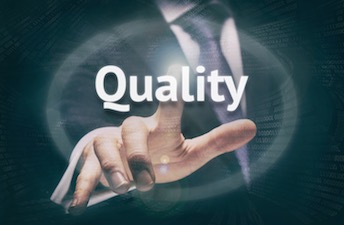 The term quality patent gets used frequently within the industry, but what does it actually mean? For some patent quality means that few, if any, patents should issue. For others, patent quality relates to concerns over whether patent examiners are finding and applying the best prior art possible. For others still, patent quality is about fairness and awarding a valid patent when one is deserved regardless of the patent examiner or Art Unit assigned.
The term quality patent gets used frequently within the industry, but what does it actually mean? For some patent quality means that few, if any, patents should issue. For others, patent quality relates to concerns over whether patent examiners are finding and applying the best prior art possible. For others still, patent quality is about fairness and awarding a valid patent when one is deserved regardless of the patent examiner or Art Unit assigned.
To a large extent the meaning of the term depends on your viewpoint, but for patent owners the term patent quality is all about value. Indeed, from the patent owner’s perspective it is virtually impossible to divorce any discussion of patent quality from patent value. This should hardly be surprising. A patent that is guaranteed to have only valid patent claims but which is extraordinarily narrow may be a quality patent in the eyes of some, but commercially useful it will not be. Thus, from the standpoint of a patent owner patent quality must necessarily be a function of value.
Of course, at least for the patent practitioner, the question of patent quality must start at the very beginning of the process. As the old saying goes, garbage in garbage out. Therefore, to have any hope of obtaining a patent worth owning— a quality patent for the patent owner— quality patent applications must be prepare and a quality prosecution of the filed patent application must take place.
Patents Not Always Presumed Valid
Unfortunately, gone are the days where the industry operated on what Chief Judge Paul Michel (CAFC, ret.) has called the honor system, where licenses were obtained and payments made for the use of patented technology. Today the value of a patent, for better or worse, is directly linked to the likelihood that the patent can be successfully enforced in litigation. The value of the patent is also a function of the likely damages that could be obtained in litigation assuming infringement can be proven.
According to the law patents are supposed to be presumed valid once issued. See 35 U.S.C. 282. This presumption of validity has been significantly eroded in odd and mysterious ways since the passage of the America Invents Act (AIA) and the birth of the Patent Trial and Appeal Board (PTAB) at the United States Patent and Trademark Office (USPTO). The new post-grant procedures ushered in by the AIA were conceived to be a cheaper, faster alternative to district court litigation, giving challengers the opportunity to challenge validity of issued patents at the USPTO in an administrative trial. The rules adopted by the USPTO ignore the presumption of validity, and the United States Court of Appeals for the Federal Circuit has allowed the PTAB to treat challenged patents without a presumption of validity.
Coping with the New Patent Reality
In this anti-patent climate the issuance of a patent simply does guarantee that the underlying innovation is of any kind of foundational importance, or that the patent and claims are written in ways that suggest the patented innovation is valuable. The granting of the patent does not even guarantee that the claims will be presumed valid, despite what Congress and the Supreme Court have said on the matter to the contrary.
For the time being that means that patent owners must go farther than ever before to ensure that the rights they are obtaining are going to be able to stand up to challenge, both challenges in the federal district court that afford the patent owner property right protections and challenges at the PTAB that are one-sided against the patent owner and fundamentally unfair.
Getting whatever you can sneak by a patent examiner probably never was a wise strategy, but today it is worse than useless. If you get patent claims that won’t stand the test of time all you are doing is wasting the client’s prosecution budget, forcing them to pay for the issuance of meaningless rights, and then maintain a patent that is nothing more than a dead weight on a portfolio.
This reality, however inconvenient, drives a tangible need for patent professionals to develop a reliable set of objective patent quality factors that can be used to help ensure that a proper foundation for patent rights is being laid and the rights that are being obtained are not unnecessarily encumbered by careless drafting, needless amendments or detrimental admissions. It also means that at times hard decisions will need to be made about the continued viability of a patent application, and perhaps filing that 6th or 7th Request for Continued Examination doesn’t make a lot of sense. If a patent application is that important you may need to actually file an appeal.
Obviously, there are a lot of considerations that go into prosecution strategy, and perhaps stalling and waiting for a better climate is the best strategy, such as in certain software related fields or when dealing with gene patents, for example. No one size fits all strategy can be employed any longer by those who want to achieve good, strong patent rights.

![[IPWatchdog Logo]](https://ipwatchdog.com/wp-content/themes/IPWatchdog%20-%202023/assets/images/temp/logo-small@2x.png)

![[[Advertisement]]](https://ipwatchdog.com/wp-content/uploads/2024/04/Patent-Litigation-Masters-2024-banner-early-bird-ends-Apr-21-last-chance-938x313-1.jpeg)
![[Advertisement]](https://ipwatchdog.com/wp-content/uploads/2024/04/Patent-Litigation-Masters-2024-sidebar-early-bird-ends-Apr-21-last-chance-700x500-1.jpg)

![[Advertisement]](https://ipwatchdog.com/wp-content/uploads/2021/12/WEBINAR-336-x-280-px.png)
![[Advertisement]](https://ipwatchdog.com/wp-content/uploads/2021/12/2021-Patent-Practice-on-Demand-recorded-Feb-2021-336-x-280.jpg)
![[Advertisement]](https://ipwatchdog.com/wp-content/uploads/2021/12/Ad-4-The-Invent-Patent-System™.png)







Join the Discussion
No comments yet.